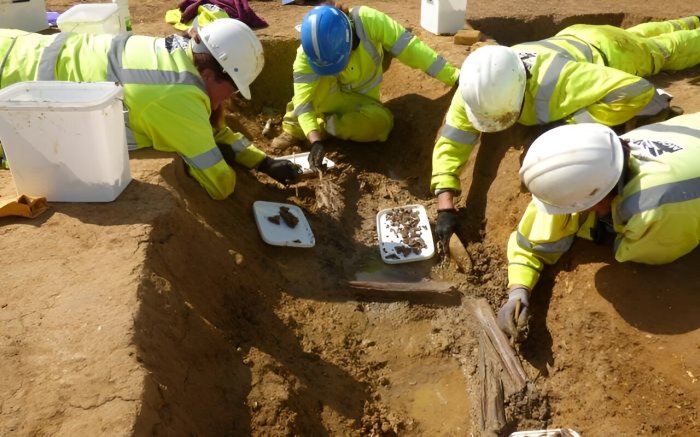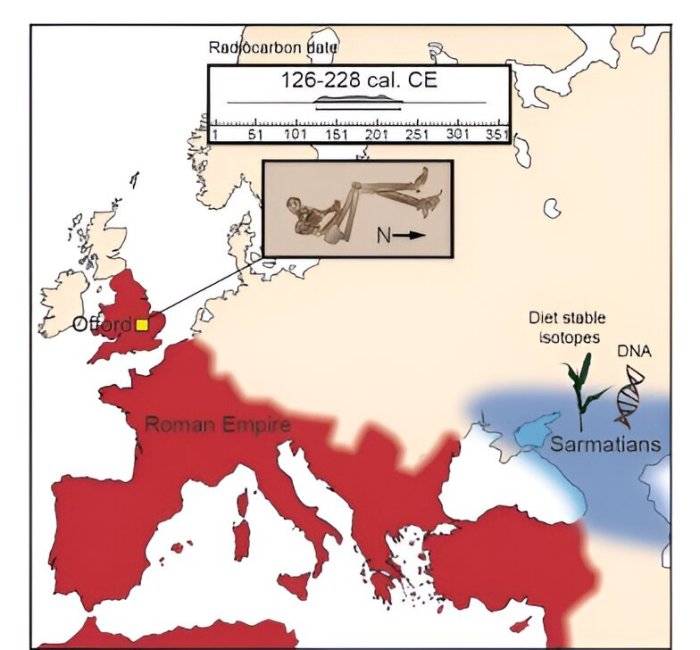Jan Bartek – AncientPages.com – Archaeologists excavating near the village of Offord Cluny in Cambridgeshire have discovered the remains of a man who lived between AD 126–228 during the Roman period and did not originally come from a rural farmstead near where he was buried but likely thousands of miles away, possibly outside of the Roman Empire.

Archaeologists excavate the Offord Cluny 203645 burial. Credit: MOLA Headland Infrastructure
A team of scientists from the Francis Crick Insтιтute, Durham University, and MOLA Headland Infrastructure carried out the excavations.
The man, known as Offord Cluny 203645, was buried by himself in a trackway ditch without any personal possessions, so this analysis gave archaeologists a glimpse into his life.
In a study published in the journal Current Biology, researchers report the Offord Cluny 203645 carried ancestry related to people in the Caucasus and Sarmatian individuals. The Sarmatians, Iranian-speaking nomadic peoples, were renowned horse riders who mainly lived in an area around modern-day southern Russia and Ukraine.
DNA analysis highlights unique ancestry
DNA analysis was conducted as part of a Wellcome Trust project on ancient genomes in Britain led by Pontus Skoglund, Head of the Ancient Genomics Laboratory at the Francis Crick Insтιтute.
“We began by extracting and sequencing ancient DNA (aDNA) from the bone of the individual’s inner ear, as this is where it is best preserved. This is not like testing the DNA of someone who is alive, as the DNA is very fragmented and damaged. However, we were able to sequence enough of his DNA to good quality and compared it to samples of people who lived at different times and places in the past.
The first thing we saw was that genetically he was very different to the other Romano-British individuals studied so far. In fact, our analysis showed that he had common ancestors with previously studied individuals from the Caucasus and Sarmatian groups,” Marina Soares de Silva, postdoctoral fellow in the Ancient Genomics Laboratory at the Crick, said.
As DNA testing alone could not confirm that the man was born outside Britain, as it could have been his parents who moved, the team turned to other types of analysis.
Clues from teeth show a change in diet and location
Researchers from the Department of Archaeology at Durham University analyzed isotopes (forms of the elements carbon, nitrogen, strontium, and oxygen) from the man’s teeth, to see the environment he grew up in and how his diet changed throughout his life.
“This is an exciting study that very effectively combines aDNA and isotope evidence. The isotopes tell us that he, and not his ancestors, made the journey to Britain. Until the age of 5 or 6, he lived in an arid location in the east of continental Europe. His diet at this age contained a lot of C4 crops, such as millet and sorghum, which are not native to Europe.

Until age 5 or 6, Offord Cluny 203645 ate plants commonly available in arid locations outside of Western or Northern Europe (Sarmatia in blue). A change in diet around the age of 6, and again after the age of 9, suggested he moved into Southeastern or Central Europe (Roman Empire in red) as a child, before arriving in Britain and dying aged 18–25. Credit: Joe Brock, the Francis Crick Insтιтute
As he grew up, he migrated west, and these plants disappeared from his diet. We have speculated for several years where the few people we find in Roman Britain with C4 diets could have come from and now we have an answer,” Janet Montgomery, Professor at Durham University said.
An extraordinary journey through the Roman Empire
In 175 AD Emperor Marcus Aurelius defeated a Sarmatian army on the northeastern border of the Roman Empire and incorporated their cavalry into his legions. According to the historian Cᴀssius Dio (ca. AD 163–235), Marcus Aurelius sent about 5,500 of these Sarmatians to join the Roman legions in Britain.
The team radiocarbon dated the Offord Cluny burial to 126–228 AD, so the deployment of Sarmatian cavalry could be one possible explanation for his arrival to Britain, but this would not necessarily mean that he would have been a soldier himself, especially given he was a child when he moved.
“The isotopic analysis shows this individual was clearly young at the time he began his journey across the Roman Empire. This ties into previous burial evidence from Britain which suggests entire families may have joined the 5,500 members of the Sarmatian cavalry sent to Britain by Marcus Aurelius.

Sarmatians warriors. From Costumes of All Nations (1882). Credit: Public Domain
“Did this young man grow up to become part of this cavalry unit? We can’t say, because we don’t have any finds or objects from his grave that connect him to either the Roman army, or the Sarmatians. Generally, we have very limited evidence for the Sarmatians stationed in Britain. We know they were likely on Hadrian’s Wall, and at Catterick in North Yorkshire, but they may well have been divided across the country. If this young man was part of the cavalry, then perhaps he died on route to a military site,” Alex Smith, post-excavation manager for MOLA Headland Infrastructure, said.
During the Roman period, long-distance travel was common. People moved from one far edge of the empire to the other, because of economic migration, war, slavery, and to take part in governing the empire.
“The effects of these movements are usually seen in cities or military locations. It has previously been argued that rural life was largely unaffected by Roman rule—but this shows a clear influence in rural areas,” said Tom Booth, Senior Laboratory Research Scientist in the Ancient Genomics Laboratory at the Crick.
See also: More Archaeology News
Whatever the reasons for this young man’s extraordinary journey, his burial highlights how the entire Roman Empire was deeply connected, from the Caucasus to rural Cambridgeshire.
The study was published in the journal Current Biology
Written by Jan Bartek – AncientPages.com Staff Writer





